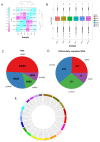Whole-transcriptome RNA sequencing reveals global expression dynamics and ceRNA regulatory networks related to hair follicle development and melanogenesis in goats
- PMID: 40211852
- PMCID: PMC12415471
- DOI: 10.5713/ab.24.0617
Whole-transcriptome RNA sequencing reveals global expression dynamics and ceRNA regulatory networks related to hair follicle development and melanogenesis in goats
Abstract
Objective: Domestic animals, fur is a product of long-term selection by humans and the natural environment. It is generally used to distinguish between different breeds. This study aims to dissect the molecular mechanisms underlying the distinct fur characteristics of goats, particularly focusing on the molecular and regulatory differences between the Dazu Black Goat (DBG) and the Inner Mongolia Cashmere Goat (IMCG). Through whole-transcriptome analysis, we aim to identify differentially expressed RNAs and construct a ceRNA network to reveal the genetic regulation of goat hair follicle development and melanin production.
Methods: Skin, hair, and cashmere samples were collected from DBG (n = 15) and IMCG (n = 17) to assess hair follicle density, length, diameter, and melanin content. Whole-transcriptome sequencing of skin tissues from DBG (n = 3) and IMCG (n = 3) identified 50,652 RNAs. Differential expression analysis was performed on mRNAs, lncRNAs, miRNAs, and circRNAs.
Results: IMCG exhibited significantly higher hair follicle density, hair length, and cashmere diameter than DBG (p < 0.01), whereas DBG had significantly thicker hair and higher melanin content (p < 0.01). A total of 640 differentially expressed RNAs were identified, including 157 mRNAs, 234 lncRNAs, 72 miRNAs, and 177 circRNAs. These were enriched in pathways related to melanogenesis, hair follicle development, and GO terms such as collagen fiber organization and pigmentation. ceRNA networks constructed from differentially expressed RNAs revealed key regulatory mechanisms of coat color and hair traits.
Conclusion: Whole-transcriptome sequencing revealed expression profiles and ceRNA networks involved in hair follicle development and melanogenesis in goats. These findings provide insights into the roles of coding and non-coding RNAs in fur traits, supporting future breeding strategies and textile applications.
Keywords: Coat Color; Goat; Hair Follicle; Whole Transcriptome; ceRNA.
Conflict of interest statement
No potential conflict of interest relevant to this article was reported.
Figures








Similar articles
-
Whole-transcriptome insights into follicle selection: deciphering key regulatory networks in Luxi gamecock.Front Genet. 2025 Aug 6;16:1620058. doi: 10.3389/fgene.2025.1620058. eCollection 2025. Front Genet. 2025. PMID: 40842627 Free PMC article.
-
LncRNA MSTRG.14227.1 regulates the morphogenesis of secondary hair follicles in Inner Mongolia cashmere goats via targeting ADAMTS3 by sponging chi-miR-433.J Anim Sci. 2025 Jan 4;103:skae382. doi: 10.1093/jas/skae382. J Anim Sci. 2025. PMID: 39715333
-
Comparative analysis of skin transcriptome reveals differences of cashmere fineness in different body parts of Inner Mongolia cashmere goats.Anim Biosci. 2025 Jul 11. doi: 10.5713/ab.25.0119. Online ahead of print. Anim Biosci. 2025. PMID: 40665726
-
Multi-omics and AI-driven advances in miRNA-mediated hair follicle regulation in cashmere goats.Front Vet Sci. 2025 Jul 9;12:1635202. doi: 10.3389/fvets.2025.1635202. eCollection 2025. Front Vet Sci. 2025. PMID: 40703926 Free PMC article. Review.
-
Systemic pharmacological treatments for chronic plaque psoriasis: a network meta-analysis.Cochrane Database Syst Rev. 2021 Apr 19;4(4):CD011535. doi: 10.1002/14651858.CD011535.pub4. Cochrane Database Syst Rev. 2021. Update in: Cochrane Database Syst Rev. 2022 May 23;5:CD011535. doi: 10.1002/14651858.CD011535.pub5. PMID: 33871055 Free PMC article. Updated.
References
Grants and funding
LinkOut - more resources
Full Text Sources

